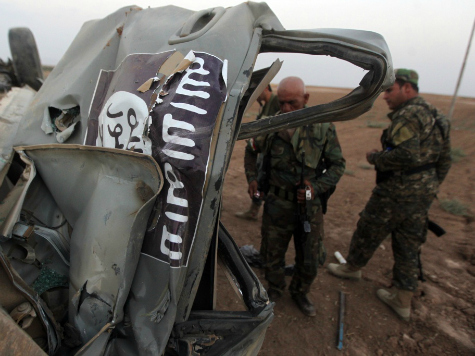Contrary to the Pentagon briefings on success of the early airstrikes on the Islamic State in Syria — “We’re going to keep the pressure on them,” said Pentagon spokesman Rear Admiral John Kirby — my Arab sources indicate the attacks have produced light casualties and negligible damage.
The claims by the Kuwait New Agency (KUNA) of “at least 400 militants” killed in the first night of the attacks are wildly exaggerated and suggest deliberate misinformation, perhaps by the militants or by the compilers of the count, the Syrian Observatory for Human Rights (SOHR) said.
A better number for the IS strikes on the first night, September 22-23, is fewer than 100, with another 150 wounded. A majority of the casualties occurred because the militants were caught by surprise. The early targets of the strikes were training camps, weapons depots and sleeping quarters.
After the initial waves, the militants have dispersed into the civilian populations. The follow-on attacks have not produced significant casualties or destruction, even by the Pentagon’s assessment.
For example, Rear Admiral Kirby has emphasized damage but not destruction to “fairly small-scale refineries” used by the militants to process a few hundred barrels of oil a day for smuggling. My sources say the strikes hit mostly large oil tankers that the militants use to transport oil to their customers in Syria, Turkey and Lebanon. The attacks on oil-smuggling capabilities continue, along with strikes at mobile weapons systems: tanks, artillery pieces and Humvees.
After a week of raids, the number and significance of the strikes have dropped quickly because there are fewer and fewer credible targets. Sensitive to the risk of civilian casualties, at the end of the week the US started an investigation into the death of a child in one of the “small-scale refineries” strikes.
As disappointing and spotty as the results of the first week’s attacks on the Islamic State in Syria were, the first-night attack on the so-called Khorasan Group near Aleppo is characterized as a counterterrorism gesture, and even that was a failure. The US has not repeated the attack for the simple reason there never was much to strike.
The so-called Khorasan Group has neither a headquarters nor military compounds; it is not a military unit. It is actually Al Qaeda in Syria. The term “Khorasan Group” is best understood as a useful construction by the Obama Administration in order to describe senior Al Qaeda agents who were dispatched to Syria by Ayman al-Zawahiri, the Al Qaeda chief, some time ago in order to get major figures out of the kill box of the Afghanistan-Pakistan borderland.
Tom Joscelyn of the Foundation for the Defense of Democracies writes bluntly, “The so-called Khorasan Group is part of core al Qaeda.” This fact has political significance for the Obama Administration, which has struggled in its partisan oratory to prove that “core Al Qaeda” is in decline.
There is nothing new about the presence of senior Al Qaeda in the Syrian civil war. According to Tom Joscelyn, two of the Al Qaeda commanders in Syria, the Kuwaiti Muhsin al Fahdli and Osama Bin Laden’s third cousin Sanafi al Nasr, have been involved in Al Qaeda operations since at least 2001. I am told to think of these agents as mentors who aim to guide their legions of protégés in Syria and Iraq, where, until recently, the militants have been safe from American drone killings.
Since the first night’s attack, the Department of Defense has qualified that the Khorasan Group was not an imminent threat, and that any plan for a transnational attack was “aspirational,” not operational. My information is that the closest the Khorasan Group has come to launching transnational attacks has been to advise jihadists to plan lone-wolf operations
I am told that the so-called Khorasan Group was included in the original strike because American intelligence authorities wanted to remind the Obama Administration that there is a transnational threat in the region, but it is not the Islamic State. The strike on the senior Al Qaeda agents – and the reported killing of an Al Qaeda sniper trainer from Turkey – may have served to make the point to the equivocating National Security Council that Bin Laden’s heirs are as dangerous as ever and far from defeated.
Finally, a surprising and troubling achievement of the American airstrikes in Syria is that they have served to unite the jihadist factions.
Before the US airstrikes, the major jihadist factions in Syria, Islamic State and Jabhat al-Nusrah (JN), agreed on nothing, not even on how to defeat their common enemy, the regime of Bashar al-Assad and its Iranian and Lebanese allies.
Since the airstrikes, however, all the jihadists are eager to set aside their differences to work together to drive America from the region.
John Batchelor is a novelist (John Calvin Batchelor) as well as the host of the nationally syndicated John Batchelor Show from the iconic 77-WABC, New York City.

COMMENTS
Please let us know if you're having issues with commenting.